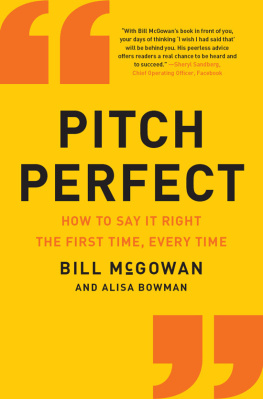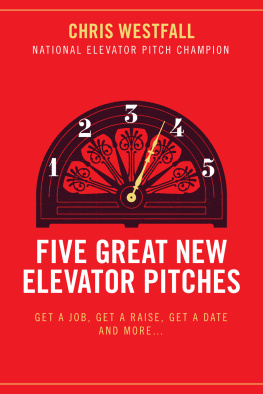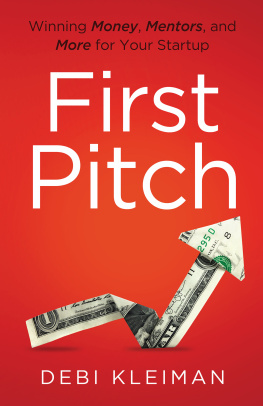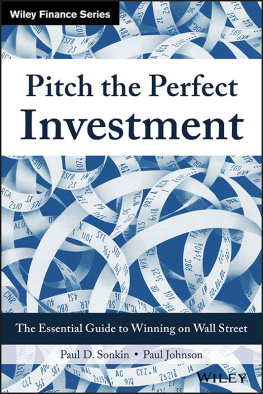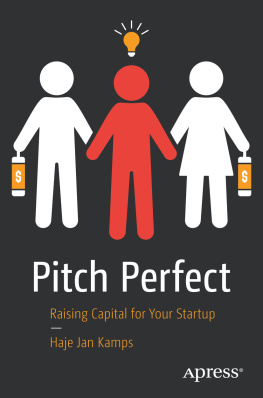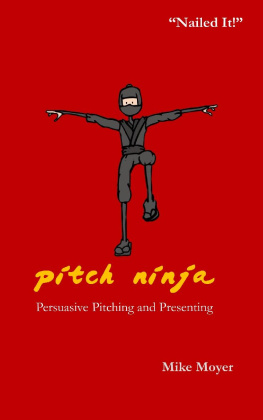To Donna, Andrew, Kara, and Paulina, all masters at communicating what matters most.
CONTENTS
P ITCH PERFECT WOULD not have happened without the generous support of many people. First, my thanks go to Alisa Bowman, my coauthor, for suggesting this collaboration several years ago, after I had coached her for a media tour for her own book. Alisa masterfully translated the tenets of our media-training sessions into the framework you see in this book and gave the project life. If it were not for Alisa, I would surely still be staring at a blank screen. Creative, smart, kind, diligent, and patient, she is everything anyone would want in a teammate.
A special thanks to Hollis Heimbouch at HarperCollins, who exhibited unbound enthusiasm for this project from our very first meeting. Her warmth, encouragement, and expert guidance made the writing process a delight. Validation that this book was distinctive and merited publishing came from my longtime friend and agent Wayne Kabak of WSK Management. To have a man of talent, wisdom, and integrity like Wayne in your corner is invaluable.
Writing this book while keeping my day job was possible thanks only to the hard work and professionalism of the entire team at Clarity Media Group. Lucy Cherkasets took control of running many aspects of the business with such skill that I have no intention of taking them back. My assistant, Mariko Takahashi, kept my chaotic schedule under control and freed up sufficient mental bandwidth for me to focus on writing. And Tiffany Sanchez was an eager sampler of random chapters, always providing encouragement that I was on the right track.
The willingness of our other Clarity coaches to shoulder a heavier workload was crucial to the books completion. Melissa Hellen stepped up big-time and delivered her usual excellence, as did Bill Cassara, Marisa Thomas, Ken Fuhr, Jim Paymar, Jennifer Fukui, Dylan Chalfy, John Johnston, and Janet Carlson.
The experiences I drew upon from thousands of training sessions were a result of the kindness and generosity of those who helped grow our business over the past thirteen years. The following, in alphabetical order, have transcended the status of client and are regarded at Clarity as business-building benefactors: Roger Ailes, Howard Arenstein, Laura Arrillaga-Andreessen, Brandee Barker, Wajma Basharyar, Emi Battaglia, Winnie Beatty, Mike Bertolino, Gurdon Blackwell, Julia Boorstin, Jacques Brand, Adam Bryant, Jerry Buckley, Rebecca Caruso, Sean Cassidy, Nathan Christopher, Lou Cona, Jocelyn Cordova, Karen DiSanto, Jeannine Dowling, Pat Eisemann, Daniel Ek, Sheila Feren-Thurston, Debbie Frost, Lisa Green, Carol Giardino, Maire Griffin, Judy Grossman, Carisa Hays, Susan Henderson, HL Group, Kristen Jones-Connell, Alexander Jutkowitz, Claire Kaye, Thomas Keller, Scott Lahde, Neal Lenarsky, Mary Lengle, Santina Leuci, Linda Lipman, Derek Mains, Juli Mandel-Sloves, Eli Manning, Caryn Marooney, Wynton Marsalis, Mike Mayzel, Zsoka McDonald, Diane McNulty, Dana Bowne Metz, Katie Burke Mitic, Denise Morrison, Elena Nachmanoff, Jessica OCallaghan, Tanya Pushkine, David Rhodes, Stephanie Ruhle, Sheryl Sandberg, Ruchi Sanghvi, Anthony Sanzio, Elliot Schrage, Amanda Schumacher, Nell Scovell, Pam Snook, Cara Stein, Jonny Thaw, Pamela Thomas-Graham, Matt Traub, Karyn Twaronite, Judy Twersky, Jane Ubell-Meyer, Loretta Ucelli, Jonathan Wald, Carolyn Wall, Angela Watts, Kate White, Meghan Womack, and Eileen Wu.
Ive learned the art of storytelling at the knee of so many talented people over the years, but two superstars stand out. Michael Rubin, whom I describe in chapter 4, has brilliant insights into how stories should unfold. I was lucky enough to be one of his many protgs. Peter Brennan, the creative genius behind A Current Affair , is in a league of his own when it comes to knowing what elements of a story are crucial and conveying them dramatically and efficiently.
While incredibly fortunate to have the friendship and support of these wonderful people, I am positively blessed that the most gifted writer I know and the most insightful copy editor around just also happens to be the love of my life, my wife, Donna Cornachio. To closely read every word of the manuscript with a keenly analytical and discerning eye (and a much-needed red pencil) is surely a sign of true love. Her encouragement and inspiration made this happen.
Speak little, do much.
B ENJAMIN F RANKLIN
I F JUST ONE piece of advice from this book brings you career success, dont thank me. Track down a guy named Roy Schwasinger and thank him. Youll find him in a federal prison somewhere.
I met Schwasinger thirty years ago when I was working as a correspondent for A Current Affair , the tabloid newsmagazine TV program that ran from 1986 to 1996. Schwasinger was your stereotypical bad guy. Because of the silent ch , his name nearly rhymed with swastika , further contributing to his aura of villainy. As an antigovernment activist, he was a real boil on the backside of all public and elected officials. He filed false liens, subpoenas, and arrest warrants against certain judges and prosecutors in an elaborate scheme to make their lives miserable. Even worse, he was accused of running a scam on destitute American farmers, falsely promising them, through his sham organization We the People, that he would help them win back their foreclosed farms for a mere $300 court-filing fee. Thats right, you guessed it. The cash was going straight into Schwasingers grubby pocket.
To imagine Schwasinger, think of the Great Santini on a bad acid trip. He was of medium height, a stocky man in his fifties sporting a military-style crew cut and a wardrobe straight off the rack at Sears. The permanent scowl on his face conveyed an unambiguous message: get away from me or Ill hurt you. He turned down all media requests for interviews and made himself about as scarce as a survivalist in rural Idaho.
One thing was sure: If I could get close enough to ask him some tough questions, it would make for some great TV. Little did I know just how great that footage would be.
Schwasinger ignored my requests for sit-down interviews, so I flew to Fort Collins, Colorado, met up with the camera crew, drove to Schwasingers house, and waited for him to emerge. Walking up and knocking on the door might seem to you like a logical course of action, but thats actually the last thing reporters generally do. Standing on his stoop would have allowed Schwasinger to call the police and claim that we were trespassing. It also would have tipped him off to our presence, possibly causing him to stay behind locked doors and wait until we lost interest and left town.
No, we wanted to wait until he left the house and put himself in some unprotected public place. Then we would catch him by surprise. So inside our rented Ford Explorer we sat. One hour ticked by. Then two. Then three. Then five. Then ten. This was the predigital era, long before Facebook, smartphone apps, and other distractions. Thoroughly exploring and analyzing all the current office gossip used up only about two hours. After that, the boredom-killing got more challenging. The fact that Hollywood filmmakers can make stakeouts appear glamorous is a true testament to their creative genius.
Finally, at ten the following morning, Roy emerged. We patiently watched as he got into his stinkin Lincoln and drove off. After hours of mind-numbing inactivity, I suddenly got this surge of adrenaline that caused nearly every nerve ending in my body to tingle. I even forgot how badly I had to pee.
We followed at a safe distance of several car lengths for a mile or so, until our black hat in the story pulled into a parking space outside the Larimer County Courthouse. We parked five spaces away.

